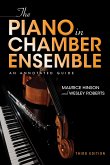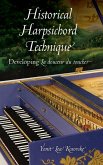Reginald R. Gerig
Famous Pianists & Their Technique
Reginald R. Gerig
Famous Pianists & Their Technique
- Broschiertes Buch
- Merkliste
- Auf die Merkliste
- Bewerten Bewerten
- Teilen
- Produkt teilen
- Produkterinnerung
- Produkterinnerung
A fascinating look at the technique of world-renowned pianists from the last two centuries
Andere Kunden interessierten sich auch für
![The Piano in Chamber Ensemble, Third Edition The Piano in Chamber Ensemble, Third Edition]() Maurice HinsonThe Piano in Chamber Ensemble, Third Edition81,99 €
Maurice HinsonThe Piano in Chamber Ensemble, Third Edition81,99 €![Historical Harpsichord Technique Historical Harpsichord Technique]() Yonit Lea KosovskeHistorical Harpsichord Technique43,99 €
Yonit Lea KosovskeHistorical Harpsichord Technique43,99 €![Adaptive Strategies for Small-Handed Pianists Adaptive Strategies for Small-Handed Pianists]() Lora Deahl (Professor of Piano and Texas Tech Keyboard LiteratureAdaptive Strategies for Small-Handed Pianists53,99 €
Lora Deahl (Professor of Piano and Texas Tech Keyboard LiteratureAdaptive Strategies for Small-Handed Pianists53,99 €![The Eighteenth-Century Fortepiano Grand and Its Patrons The Eighteenth-Century Fortepiano Grand and Its Patrons]() Eva Badura-SkodaThe Eighteenth-Century Fortepiano Grand and Its Patrons89,99 €
Eva Badura-SkodaThe Eighteenth-Century Fortepiano Grand and Its Patrons89,99 €![The Performing Pianist's Guide to Fingering The Performing Pianist's Guide to Fingering]() Joseph BanowetzThe Performing Pianist's Guide to Fingering42,99 €
Joseph BanowetzThe Performing Pianist's Guide to Fingering42,99 €![Performance Practices in Classic Piano Music Performance Practices in Classic Piano Music]() Sandra P. RosenblumPerformance Practices in Classic Piano Music37,99 €
Sandra P. RosenblumPerformance Practices in Classic Piano Music37,99 €![The Piano Book The Piano Book]() Larry FineThe Piano Book19,99 €
Larry FineThe Piano Book19,99 €-
-
-
A fascinating look at the technique of world-renowned pianists from the last two centuries
Hinweis: Dieser Artikel kann nur an eine deutsche Lieferadresse ausgeliefert werden.
Hinweis: Dieser Artikel kann nur an eine deutsche Lieferadresse ausgeliefert werden.
Produktdetails
- Produktdetails
- Indiana University Press (IPS)
- Verlag: Indiana University Press
- New Edition
- Seitenzahl: 636
- Erscheinungstermin: 5. April 2007
- Englisch
- Abmessung: 232mm x 164mm x 38mm
- Gewicht: 940g
- ISBN-13: 9780253348555
- ISBN-10: 0253348552
- Artikelnr.: 21828241
- Herstellerkennzeichnung
- Libri GmbH
- Europaallee 1
- 36244 Bad Hersfeld
- gpsr@libri.de
- Indiana University Press (IPS)
- Verlag: Indiana University Press
- New Edition
- Seitenzahl: 636
- Erscheinungstermin: 5. April 2007
- Englisch
- Abmessung: 232mm x 164mm x 38mm
- Gewicht: 940g
- ISBN-13: 9780253348555
- ISBN-10: 0253348552
- Artikelnr.: 21828241
- Herstellerkennzeichnung
- Libri GmbH
- Europaallee 1
- 36244 Bad Hersfeld
- gpsr@libri.de
Reginald R. Gerig is Professor of Piano Emeritus at Wheaton College in Wheaton, Illinois, where he taught from 1952 to 1987, having served as Chair of the Piano Department for fourteen of those years. He was previously also on faculty at the Eastman School of Music and received several degrees from The Juilliard School of Music.
Foreword by Alan Walker
Preface and Acknowledgments
1. The Meaning of Technique
2. The Early Clavier Methods
3. The Beginnings of the Piano
4. Mozart and the Early Piano Technique
5. Hummel: The Culmination of the Viennese Era
6. The Dynamic Beethoven Technique
7. Czerny: Technique Personified
8. The Early Methodology
9. The Lyricism of Chopin
10. Liszt and Virtuoso Technique
11. The Schumann Circle
12. The Beginnings of Modern Technical Methods
13. The Leschetizky Influence
14. Russian Nationalism
15. The French School
16. Breithaupt and Weight Technique
17. The English School: Matthay; His Pupils and Colleagues
18. Ortmann: Piano Technique Comes of Age
19. Contemporary Technical Thought
20. The Perspectives of an Enlightened Piano Technique
Appendices
1. The Aesthetic Imperative
2. Mental and Psychological Control
3. An Intellectual Grasp of Basic Technical Knowledge
4. Isolated Movements
5. Coordinated Movements
6. Muscular Coordination
7. The Kinesthetic Sense
8. Posture
9. Means for Specific Technical Development
10. Historical Concepts and Perspectives of Piano Technical Thought
11. Supplementary Bibliography
Bibliography
Glossary
Index
Preface and Acknowledgments
1. The Meaning of Technique
2. The Early Clavier Methods
3. The Beginnings of the Piano
4. Mozart and the Early Piano Technique
5. Hummel: The Culmination of the Viennese Era
6. The Dynamic Beethoven Technique
7. Czerny: Technique Personified
8. The Early Methodology
9. The Lyricism of Chopin
10. Liszt and Virtuoso Technique
11. The Schumann Circle
12. The Beginnings of Modern Technical Methods
13. The Leschetizky Influence
14. Russian Nationalism
15. The French School
16. Breithaupt and Weight Technique
17. The English School: Matthay; His Pupils and Colleagues
18. Ortmann: Piano Technique Comes of Age
19. Contemporary Technical Thought
20. The Perspectives of an Enlightened Piano Technique
Appendices
1. The Aesthetic Imperative
2. Mental and Psychological Control
3. An Intellectual Grasp of Basic Technical Knowledge
4. Isolated Movements
5. Coordinated Movements
6. Muscular Coordination
7. The Kinesthetic Sense
8. Posture
9. Means for Specific Technical Development
10. Historical Concepts and Perspectives of Piano Technical Thought
11. Supplementary Bibliography
Bibliography
Glossary
Index
Foreword by Alan Walker
Preface and Acknowledgments
1. The Meaning of Technique
2. The Early Clavier Methods
3. The Beginnings of the Piano
4. Mozart and the Early Piano Technique
5. Hummel: The Culmination of the Viennese Era
6. The Dynamic Beethoven Technique
7. Czerny: Technique Personified
8. The Early Methodology
9. The Lyricism of Chopin
10. Liszt and Virtuoso Technique
11. The Schumann Circle
12. The Beginnings of Modern Technical Methods
13. The Leschetizky Influence
14. Russian Nationalism
15. The French School
16. Breithaupt and Weight Technique
17. The English School: Matthay; His Pupils and Colleagues
18. Ortmann: Piano Technique Comes of Age
19. Contemporary Technical Thought
20. The Perspectives of an Enlightened Piano Technique
Appendices
1. The Aesthetic Imperative
2. Mental and Psychological Control
3. An Intellectual Grasp of Basic Technical Knowledge
4. Isolated Movements
5. Coordinated Movements
6. Muscular Coordination
7. The Kinesthetic Sense
8. Posture
9. Means for Specific Technical Development
10. Historical Concepts and Perspectives of Piano Technical Thought
11. Supplementary Bibliography
Bibliography
Glossary
Index
Preface and Acknowledgments
1. The Meaning of Technique
2. The Early Clavier Methods
3. The Beginnings of the Piano
4. Mozart and the Early Piano Technique
5. Hummel: The Culmination of the Viennese Era
6. The Dynamic Beethoven Technique
7. Czerny: Technique Personified
8. The Early Methodology
9. The Lyricism of Chopin
10. Liszt and Virtuoso Technique
11. The Schumann Circle
12. The Beginnings of Modern Technical Methods
13. The Leschetizky Influence
14. Russian Nationalism
15. The French School
16. Breithaupt and Weight Technique
17. The English School: Matthay; His Pupils and Colleagues
18. Ortmann: Piano Technique Comes of Age
19. Contemporary Technical Thought
20. The Perspectives of an Enlightened Piano Technique
Appendices
1. The Aesthetic Imperative
2. Mental and Psychological Control
3. An Intellectual Grasp of Basic Technical Knowledge
4. Isolated Movements
5. Coordinated Movements
6. Muscular Coordination
7. The Kinesthetic Sense
8. Posture
9. Means for Specific Technical Development
10. Historical Concepts and Perspectives of Piano Technical Thought
11. Supplementary Bibliography
Bibliography
Glossary
Index








